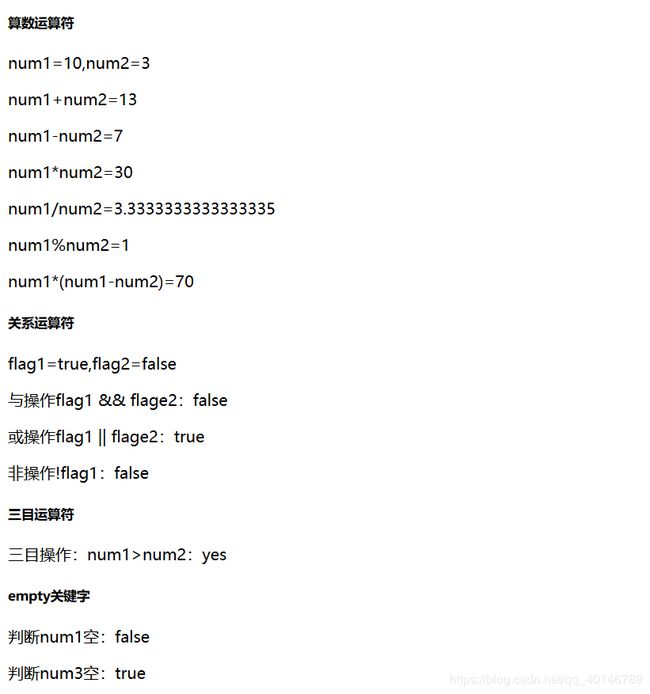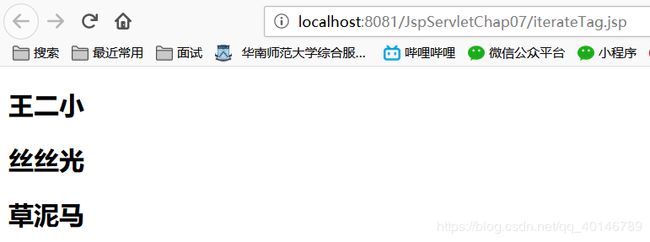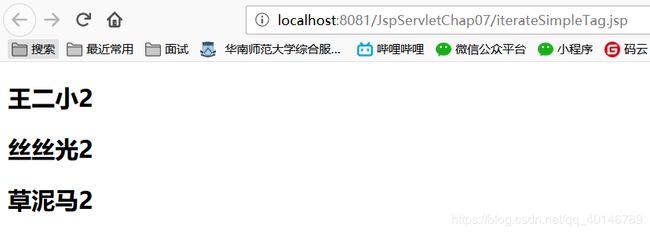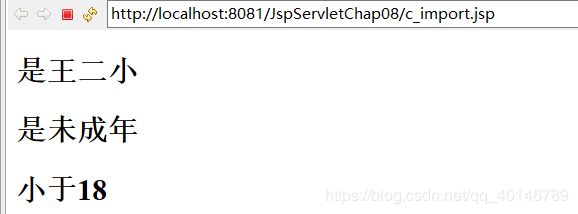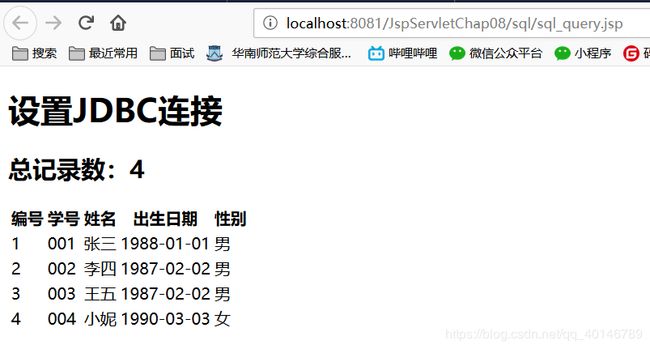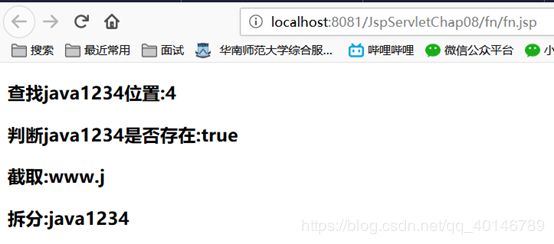Jsp&Servlet学习笔记(二)
Jsp&Servlet学习笔记(二)
第六章EL 表达式
第一节:EL 表达式简介
表达式语言(Expression Language,EL)
提供了在 JSP 中简化表达式的方法,让Jsp的代码更加简化。
第二节:EL 表达式内置对象
1、pageContext 表示javax.servlet.jsp.PageContext 对象
2、pageScope 表示从page 属性范围查找输出属性
3、requestScope 表示从request 属性范围查找输出属性
4、sessionScope 表示从session 属性范围查找输出属性
5、applicationScope 表示从application 属性范围查找输出属性
6、param 接收传递到本页面的参数
7、paramValues 接收传递到本页面的一组参数
8、header 取得一个头信息数据
9、headerValues 取出一组头信息数据
10、cookie 取出cookie 中的数据
11、initParam 取得配置的初始化参数
第三节:EL 表达式访问4 种范围属性
寻找值的顺序:page->request->session->application
<body>
<%
pageContext.setAttribute("info1","page范围的值");
request.setAttribute("info1","request范围的值");
session.setAttribute("info1","session范围的值");
application.setAttribute("info1","application范围的值");
%>
<h1>${info1 }h1>
body>
执行结果是:page范围的值
第四节:EL 表达式接收请求参数
param:单个参数
paramValues:一组参数
<body>
<form action="el2.jsp" method="post">
<input type="text" name="name"/>
<input type="submit" value="提交el2.jsp"/>
form>
<a href="el2.jsp?age=12">提交el2.jspa>
<form action="el2.jsp" method="post">
<input type="checkbox" name="hobby" value="java语言"/>java语言
<input type="checkbox" name="hobby" value="C#语言"/>C#语言
<input type="checkbox" name="hobby" value="php语言"/>php语言
<input type="submit" value="提交el2.jsp"/>
form>
body>
//el2.jsp
<body>
<%
request.setCharacterEncoding("utf-8");
%>
<h1>姓名:${param.name }h1>
<h1>年龄:${param.age }h1>
<h1>爱好一:${paramValues.hobby[0] }h1>
<h1>爱好二:${paramValues.hobby[1] }h1>
<h1>爱好三:${paramValues.hobby[2] }h1>
body>
第五节:EL 表达式对象操作
<%@page import="com.java1234.model.People" %>
<body>
<%
People zhangsan=new People();
zhangsan.setId(1);
zhangsan.setName("张三");
zhangsan.setAge(20);
pageContext.setAttribute("zhangsan",zhangsan);
%>
<h1>编号:${zhangsan.id }h1>
<h1>姓名:${zhangsan.name }h1>
<h1>年龄:${zhangsan.age }h1>
body>
第六节:EL 表达式集合操作
<%@ page import="java.util.*" %>
<body>
<%
List all=new LinkedList();
all.add(0,"元素一");
all.add(1,"元素二");
all.add(2,"元素三");
request.setAttribute("all",all);
%>
<h1>${all[0] }h1>
<h1>${all[1] }h1>
<h1>${all[2] }h1>
body>
第七节:EL 表达式运算符操作
算数运算符,关系运算符,逻辑运算符;
三目运算符;
empty 关键字:判断是否空
<body>
<%
request.setAttribute("num1",10);
request.setAttribute("num2",3);
request.setAttribute("flag1",true);
request.setAttribute("flag2",false);
%>
<h5>算数运算符h5>
<p>num1=${num1 },num2=${num2 }p>
<p>num1+num2=${num1+num2 }p>
<p>num1-num2=${num1-num2 }p>
<p>num1*num2=${num1*num2 }p>
<p>num1/num2=${num1/num2 }p>
<p>num1%num2=${num1%num2 }p>
<p>num1*(num1-num2)=${num1*(num1-num2) }p>
<h5>关系运算符h5>
<p>flag1=${flag1 },flag2=${flag2 }p>
<p>与操作flag1 && flage2:${flag1 && flage2 }p>
<p>或操作flag1 || flage2:${flag1 || flage2 }p>
<p>非操作!flag1:${!flag1}p>
<h5>三目运算符h5>
<p>三目操作:num1>num2:${num1>num2?"yes":"no" }p>
<h5>empty关键字h5>
<p>判断空操作:${empty num1 }p>
<p>判断空操作:${empty num3 }p>
body>
第七章Jsp 自定义标签
第一节:Jsp 自定义标签简介
Jsp自定义标签在功能上逻辑上与javaBean 类似,都封装Java代码。自定义标签是可重用的组件代码,并且允许开发人员为复杂的操作提供逻辑名称。
JSP开发人员使用标签库创建标签.标签库是按照功能或实现进行分组的自定义标签的集合。
第二节:问候自定义标签他大爷
//HelloWorldTag.java
package com.java1234.tag;
import java.io.IOException;
public class HelloWorldTag extends TagSupport {
private static final long serialVersionUID = 1L;
@Override
public int doStartTag() throws JspException {
// TODO Auto-generated method stub
JspWriter out=this.pageContext.getOut();
try {
out.print("自定义标签大爷你好!");
} catch (IOException e) {
// TODO Auto-generated catch block
e.printStackTrace();
}
return TagSupport.SKIP_BODY; //直接结束标签
}
}
//WEB-INF目录下新建一个java1234.tld文件,配置
<tag>
<name>helloWorldname>
<tag-class>
com.java1234.tag.HelloWorldTag
tag-class>
<body-content>emptybody-content>
tag>
//helloWorldTag.jsp
<%@ taglib prefix="java1234" uri="/WEB-INF/java1234.tld" %>
<body>
<java1234:helloWorld/>
body>
运行结果如图:
第三节:自定义有属性的标签
在上面的HelloWorldTag.java添加name属性,文件命名为HelloWorldTag2.java
public class HelloWorldTag2 extends TagSupport {
private static final long serialVersionUID = 1L;
private String name;
public String getName() {
return name;
}
public void setName(String name) {
this.name = name;
}
@Override
public int doStartTag() throws JspException {
// TODO Auto-generated method stub
JspWriter out=this.pageContext.getOut();
try {
out.print(name+"自定义标签大爷你好!");
} catch (IOException e) {
// TODO Auto-generated catch block
e.printStackTrace();
}
return TagSupport.SKIP_BODY; //直接结束标签
}
}
配置Java234.tld文件
<tag>
<name>helloWorld2name>
<tag-class>
com.java1234.tag.HelloWorldTag2
tag-class>
<body-content>emptybody-content>
<attribute>
<name>namename>
<required>truerequired>
<rtexprvalue>truertexprvalue>
attribute>
tag>
helloWorldTag.jsp
<body>
<java1234:helloWorld2 name="JspServlet屌炸天"/>
body>
运行结果:
第四节:自定义有标签体的标签
//IterateTag.java,tld文件配置略
public class IterateTag extends TagSupport{
private static final long serialVersionUID = 1L;
private String var;
private String items;
private Iterator iter;
public String getVar() {
return var;
}
public void setVar(String var) {
this.var = var;
}
public String getItems() {
return items;
}
public void setItems(String items) {
this.items = items;
}
public Iterator getIter() {
return iter;
}
public void setIter(Iterator iter) {
this.iter = iter;
}
@Override
public int doStartTag() throws JspException {
Object value=this.pageContext.getAttribute(items); //items="people"
if(value!=null && value instanceof List){
this.iter=((List)value).iterator();
if(iter.hasNext()){
this.pageContext.setAttribute(var, iter.next()); //var="p"
return TagSupport.EVAL_BODY_INCLUDE; // 执行标签体
}else{
return TagSupport.SKIP_BODY; // 退出标签执行
}
}else{
return TagSupport.SKIP_BODY; // 退出标签执行
}
}
@Override
public int doAfterBody() throws JspException {
if(iter.hasNext()){
this.pageContext.setAttribute(var, iter.next());
return TagSupport.EVAL_BODY_AGAIN; // 再执行一次标签体
}else{
return TagSupport.SKIP_BODY; // 退出标签执行
}
}
}
//iterateTag.jsp
<body>
<%
List people=new ArrayList();
people.add(0,"王二小");
people.add(1,"丝丝光");
people.add(2,"草泥马");
pageContext.setAttribute("people", people);
%>
<java1234:iterate items="people" var="p">
<h2>${p }h2>
java1234:iterate>
body>
第五节:简单标签
//IterateSimpleTag.java,tld文件配置略
public class IterateSimpleTag extends SimpleTagSupport{
private static final long serialVersionUID = 1L;
private String var;
private String items;
public String getVar() {
return var;
}
public void setVar(String var) {
this.var = var;
}
public String getItems() {
return items;
}
public void setItems(String items) {
this.items = items;
}
@Override
public void doTag() throws JspException, IOException {
Object value=this.getJspContext().getAttribute(items);
if(value!=null && value instanceof List){
Iterator iter=((List)value).iterator();
while(iter.hasNext()){
this.getJspContext().setAttribute(var, iter.next());
this.getJspBody().invoke(null); // 响应页面
}
}
}
}
//iterateSimpleTag.jsp
<body>
<%
List people=new ArrayList();
people.add("王二小2");
people.add("丝丝光2");
people.add("草泥马2");
pageContext.setAttribute("people", people);
%>
<java1234:iterate2 items="people" var="p">
<h2>${p }h2>
java1234:iterate2>
body>
第八章Jsp 标准标签库
第一节:JSTL 引入
JSTL(JSP Standard Tag Library ,JSP 标准标签库)
第二节:问候JSTL 他大爷
<%@ taglib uri="http://java.sun.com/jsp/jstl/core" prefix="c"%>
<body>
<c:out value="jstl大爷你好">c:out>
body>
第三节:JSTL 核心标签库
c:out 内容输出标签;
<%@ taglib uri="http://java.sun.com/jsp/jstl/core" prefix="c"%>
<body>
<%
pageContext.setAttribute("people","张三");
%>
<h2><c:out value="${people}">c:out>h2>
<h2><c:out value="${people2}" default="某人">c:out>h2>
c:set 用来设置4种属性范围值的标签;
<body>
<c:set var="people" value="张三" scope="request">c:set>
<h2><c:out value="${people}">c:out>h2>
<jsp:useBean id="people2" class="com.java1234.model.People" scope="page">jsp:useBean>
<c:set property="id" target="${people2 }" value="007">c:set>
<c:set property="name" target="${people2 }" value="王二小">c:set>
<c:set property="age" target="${people2 }" value="16">c:set>
<h2>编号:${people2.id }h2>
<h2>姓名:${people2.name }h2>
<h2>年龄:${people2.age }h2>
body>
c:remove 用来删除指定范围中的属性;
<body>
<c:set var="people" value="张三" scope="request">c:set>
<h2><c:out value="${people}" default="没人啊">c:out>h2>
<c:remove var="people" scope="request"/>
<h2><c:out value="${people}" default="没人啊">c:out>h2>
body>
c:catch 用来处理程序中产生的异常;
<body>
<c:catch var="errMsg">
<%
int a=1/0;
%>
c:catch>
<h2>异常信息:${errMsg }h2>
body>
c:if 用来条件判断;
<body>
<jsp:useBean id="people" class="com.java1234.model.People" scope="page">jsp:useBean>
<c:set property="id" target="${people }" value="007">c:set>
<c:set property="name" target="${people }" value="王二小">c:set>
<c:set property="age" target="${people }" value="16">c:set>
<c:if test="${people.name=='王二小' }" var="r" scope="page">
<h2>是王二小h2>
c:if>
<c:if test="${people.age<18 }">
<h2>是未成年h2>
c:if>
body>
c:choose、c:when、c:otherwise 用来多条件判断;
<body>
<jsp:useBean id="people" class="com.java1234.model.People" scope="page">jsp:useBean>
<c:set property="id" target="${people }" value="007">c:set>
<c:set property="name" target="${people }" value="王二小">c:set>
<c:set property="age" target="${people }" value="19">c:set>
<c:choose>
<c:when test="${people.age<18 }">
<h2>小于18h2>
c:when>
<c:when test="${people.age==18 }">
<h2>等于18h2>
c:when>
<c:otherwise>
<h2>大于18h2>
c:otherwise>
c:choose>
body>
c:forEach 用来遍历数组或者集合;
<%@ page import="com.java1234.model.*"%>
<%@ page import="java.util.*"%>
<%@ taglib uri="http://java.sun.com/jsp/jstl/core" prefix="c"%>
<body>
<%
String dogs[]={"小黑","小黄","小白","小小"};
pageContext.setAttribute("dogs",dogs);
%>
<c:forEach var="dog" items="${dogs }">
${dog }
c:forEach>
<hr/>
<c:forEach var="dog" items="${dogs }" step="2">
${dog }
c:forEach>
<hr/>
<c:forEach var="dog" items="${dogs }" begin="1" end="2">
${dog }
c:forEach>
<hr/>
<%
List
pList.add(new People(1,"张三",10));
pList.add(new People(2,"李四",20));
pList.add(new People(3,"王五",30));
pageContext.setAttribute("pList",pList);
%>
<table>
<tr>
<th>编号th>
<th>姓名th>
<th>年龄th>
tr>
<c:forEach var="p" items="${pList }">
<tr>
<td>${p.id }td>
<td>${p.name }td>
<td>${p.age }td>
tr>
c:forEach>
table>
body>
c:fortoke ns 分隔输出;
<body>
<%
String str1="www.java1234.com";
String str2="张三,李四,王五";
pageContext.setAttribute("str1",str1);
pageContext.setAttribute("str2",str2);
%>
<c:forTokens items="${str1 }" delims="." var="s1">
${s1 }
c:forTokens>
<hr/>
<c:forTokens items="${str2 }" delims="," var="s2">
${s2 }
c:forTokens>
body>
c:import 导入页面;
<body>
<c:import url="c_if.jsp">c:import>
<c:import url="c_choose.jsp">c:import>
body>
c:url 生成一个url 地址;
<body>
<c:url value="http://www.java1234.com" var="url">
<c:param name="name" value="xiaofeng">c:param>
<c:param name="age" value="26">c:param>
c:url>
<a href="${url }">Java知识分享网a>
body>
c:redirect 客户端跳转
<body>
<c:redirect url="target.jsp">
<c:param name="name" value="xiaofeng">c:param>
<c:param name="age" value="26">c:param>
c:redirect>
body>
//target.jsp
<body>
<h2>姓名:${param.name }h2>
<h2>年龄:${param.age }h2>
body>
第四节:JSTL 国际化标签库
fmt:setLocale 设定用户所在的区域;
fmt:formatDate 对日期进行格式化;
<%@ page import="java.util.*"%>
<%@ taglib uri="http://java.sun.com/jsp/jstl/fmt" prefix="fmt" %>
<body>
<%
pageContext.setAttribute("date",new Date());
%>
中文日期:
<fmt:setLocale value="zh_CN"/>
<fmt:formatDate value="${date }"/>
<hr/>
英文日期:
<fmt:setLocale value="en_US"/>
<fmt:formatDate value="${date }"/>
body>
fmt:requestEncoding 设置所有的请求编码;
<body>
<fmt:requestEncoding value="UTF-8"/>
body>
fmt:bundle fmt:message fmt:param 读取国际化资源;
//文件info_zh_CN.properties
name=\u5c0f\u950b
info=\u5f53\u524d\u7528\u6237{0}:\u6b22\u8fce\u4f7f\u7528\u672c\u7cfb\u7edf
//文件info_en_US.properties
name=xiaofeng
info=Current user{0}:Welcome to use our system
//fmt_bundle.jsp
<body>
<fmt:setLocale value="zh_CN"/>
<fmt:bundle basename="info">
<fmt:message key="name" var="userName"/>
fmt:bundle>
<h2>姓名:${userName }h2>
<fmt:bundle basename="info">
<fmt:message key="info" var="infomation">
<fmt:param value="<font color='red'>小锋font>"/>
fmt:message>
fmt:bundle>
<h2>信息:${infomation }h2>
<hr/>
<fmt:setLocale value="en_US"/>
<fmt:bundle basename="info">
<fmt:message key="name" var="userName"/>
fmt:bundle>
<h2>姓名:${userName }h2>
<fmt:bundle basename="info">
<fmt:message key="info" var="infomation">
<fmt:param value="<font color='red'>小锋font>"/>
fmt:message>
fmt:bundle>
<h2>信息:${infomation }h2>
body>
fmt:formatNumber 格式化数字;
<body>
<fmt:formatNumber value="12" type="currency" pattern="$.00"/>
<fmt:formatNumber value="12" type="currency" pattern="$.0#"/>
<fmt:formatNumber value="1234567890" type="currency"/>
<fmt:formatNumber value="123456.7891" pattern="#,#00.0#"/>
body>
fmt:formatDate 格式化日期;
<body>
<%
Date date=new Date();
pageContext.setAttribute("date",date);
%>
<fmt:formatDate value="${date }" pattern="yyyy-MM-dd HH:mm:ss"/>
<hr/>
<fmt:formatDate value="${date }" pattern="yyyy-MM-dd"/>
body>
fmt:timeZone 设置临时时区;
<body>
<%
Date date=new Date();
pageContext.setAttribute("date",date);
%>
当前时间:<fmt:formatDate value="${date }" pattern="yyyy-MM-dd HH:mm:ss"/>
<hr/>
格林尼治时间:
<fmt:timeZone value="GMT">
<fmt:formatDate value="${date }" pattern="yyyy-MM-dd HH:mm:ss"/>
fmt:timeZone>
body>
第五节:JSTL SQL 标签库
Sql:setDataDource 设置JDBC 连接;
<body>
<h1>设置JDBC连接h1>
<sql:setDataSource driver="com.mysql.jdbc.Driver" url="jdbc:mysql://localhost:3306/db_jstl?serverTimezone=UTC" user="root" password="password" />
body>
sql:query 数据库查询操作;
<body>
<h1>设置JDBC连接h1>
<sql:setDataSource driver="com.mysql.jdbc.Driver" url="jdbc:mysql://localhost:3306/db_jstl?serverTimezone=UTC" user="root" password="password" />
<sql:query var="result">
select * from t_student;
sql:query>
<h2>总记录数:${result.rowCount }h2>
<table>
<tr>
<th>编号th>
<th>学号th>
<th>姓名th>
<th>出生日期th>
<th>性别th>
tr>
<c:forEach var="student" items="${result.rows }">
<tr>
<td>${student.id }td>
<td>${student.stuNo }td>
<td>${student.stuName }td>
<td>${student.birthday }td>
<td>${student.sex }td>
tr>
c:forEach>
table>
body>
Sql:update 数据库添加,修改,删除操作;
<h1>添加数据h1>
<sql:update var="result" >
insert into t_student values(null,"008","草泥马","1991-1-1","男");
sql:update>
<h1>修改数据h1>
<sql:update var="result" >
update t_student set stuNo="010",sex="未知" where id=6
sql:update>
<h1>删除数据h1>
<sql:update var="result" >
delete from t_student where id=6
sql:update>
sql:transaction 数据库事务;
<h1>事务h1>
<sql:transaction>
<sql:update var="result" >
insert into t_student values(null,"008","草泥马","1991-1-1","男");
sql:update>
sql:transaction>
第六节:JSTL XML 标签库
x:parse 解析xml;
x:out 输出xml 文件的内容;
//usersInfo.xml
xml version="1.0" encoding="UTF-8"?>
<users>
<user>
<name id="n1">张三name>
<birthday>2011-1-1birthday>
user>
users>
//xml_out.jsp
<%@ taglib uri="http://java.sun.com/jsp/jstl/core" prefix="c"%>
<%@ taglib uri="http://java.sun.com/jsp/jstl/xml" prefix="x"%>
head>
<body>
<c:import var="usersInfo" url="usersInfo.xml" charEncoding="UTF-8"/>
<x:parse var="usersInfoXml" doc="${usersInfo }"/>
<h2>姓名:<x:out select="$usersInfoXml/users/user/name"/>
(ID:<x:out select="$usersInfoXml/users/user/name/@id"/>)h2>
<h2>出生日期:<x:out select="$usersInfoXml/users/user/birthday"/>h2>
body>
x:set 把xml 读取的内容保存到指定的属性范围;
<body>
<c:import var="usersInfo" url="usersInfo.xml" charEncoding="UTF-8"/>
<x:parse var="usersInfoXml" doc="${usersInfo }"/>
<x:set var="userInfoXml" select="$usersInfoXml/users/user"/>
<h2>姓名:<x:out select="$userInfoXml/name"/>h2>
body>
x:if 判断指定路径的内容是否符合判断的条件;
<body>
<c:import var="usersInfo" url="usersInfo.xml" charEncoding="UTF-8"/>
<x:parse var="usersInfoXml" doc="${usersInfo }"/>
<x:if select="$usersInfoXml/users/user/name/@id='n1'">
<h2>有编号是n1的user信息h2>
x:if>
body>
x:choose x:when x:otherwise 多条件判断;
<body>
<c:import var="usersInfo" url="usersInfo.xml" charEncoding="UTF-8"/>
<x:parse var="usersInfoXml" doc="${usersInfo }"/>
<x:choose>
<x:when select="$usersInfoXml/users/user/name/@id='n2'">
<h2>有编号是n2的user信息h2>
x:when>
<x:otherwise>
<h2>没有编号是n2的user信息h2>
x:otherwise>
x:choose>
body>
x:forEach 遍历
//usersInfo2.xml
xml version="1.0" encoding="UTF-8"?>
<users>
<user>
<name id="n1">张三name>
<birthday>2011-1-1birthday>
user>
<user>
<name id="n2">王五name>
<birthday>2011-1-2birthday>
user>
<user>
<name id="n3">赵六name>
<birthday>2011-1-3birthday>
user>
users>
//xml_forEach.jsp
<body>
<c:import var="usersInfo" url="usersInfo2.xml" charEncoding="UTF-8"/>
<x:parse var="usersInfoXml" doc="${usersInfo }"/>
<x:forEach select="$usersInfoXml/users/user" var="userInfoXml">
姓名:<x:out select="$userInfoXml/name"/><br>
出生日期:<x:out select="$userInfoXml/birthday"/>
<hr/>
x:forEach>
body>
第七节:JSTL 函数标签库
<%@ taglib uri="http://java.sun.com/jsp/jstl/functions" prefix="fn"%>
<body>
<%
pageContext.setAttribute("info","www.java1234.com");
%>
<h2>查找java1234位置:${fn:indexOf(info,"java1234")}h2>
<h2>判断java1234是否存在:${fn:contains(info,"java1234")}h2>
<h2>截取:${fn:substring(info,0,5)}h2>
<h2>拆分:${fn:split(info,".")[1]}h2>
body>
End完!
